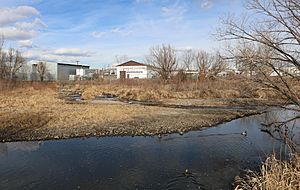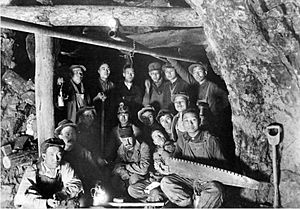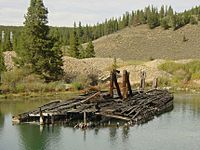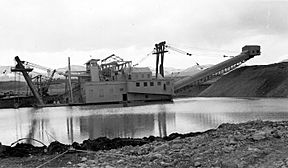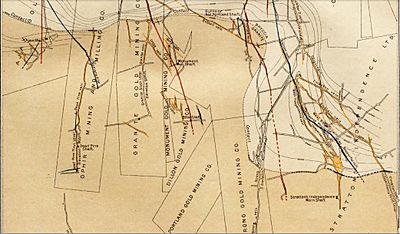Gold mining in Colorado facts for kids
Quick facts for kids Gold Mining in Colorado |
|
|---|---|
| Location | |
| State | Colorado |
| Country | United States |
| Regulatory authority | |
| Authority | Colorado Division of Reclamation Mining & Safety |
| Website | Official website: http://mining.state.co.us/ |
| Commodity | Gold |
Gold mining has been an important industry in Colorado, a state in the United States, since 1858. It played a huge part in how Colorado became a state.
An explorer named Zebulon Pike first heard about gold in South Park in 1807. This area is now called Park County, Colorado.
Gold was first found near Denver. Prospectors followed the gold from riverbeds (called placer gold) up into the mountains. They then followed a path of minerals called the Colorado Mineral Belt across the state. This path ends in the San Juan Mountains. The Cripple Creek area, which is not on this mineral belt, was one of the last places where gold was found. It is still producing gold today!
Contents
- Discovering Gold in Colorado: Early Finds
- Gold in the Denver Area: Where it All Began
- Central City and Idaho Springs: Mountain Gold
- Breckenridge: Gold from Rivers and Hills
- South Park: Gold in Valleys and Mountains
- Leadville: From Gold to Silver and Back
- Summitville: A Modern Mining Story
- Sneffels-Red Mountain-Telluride: Gold in Volcanic Areas
- Cripple Creek: Colorado's Biggest Gold Producer
- Gold Mining in Colorado Today
Discovering Gold in Colorado: Early Finds
Gold in the Denver Area: Where it All Began
On June 22, 1850, a group of travelers heading to California crossed the South Platte River. They went west along Clear Creek. A man named Lewis Ralston used his gold pan in a stream flowing into Clear Creek. He found about a quarter of an ounce of gold right away!
Another traveler, John Lowery Brown, wrote in his diary: "Lay bye. Gold found." He also noted, "We called this Ralston's Creek because a man of that name found gold here." Ralston went on to California. But he came back to 'Ralston's Creek' eight years later with the Green Russell group.
This group started a settlement called Auraria in 1858. This town later became part of Denver. Their discovery started the famous Pike's Peak Gold Rush in the Rocky Mountains. The spot where Colorado's first gold was found, where Clear Creek and Ralston Creek meet, is now in Arvada, Colorado.
In 1858, people looked for gold in the river sands around present-day Denver. They searched in Cherry Creek, Clear Creek, and the South Platte River. However, these gold deposits were small. When richer gold was found in the mountains in 1859, miners quickly left the Denver area.
Even though most of the gold was quickly taken, companies that dig for sand and gravel still find small amounts of gold today. Counties like Adams, Arapahoe, Douglas, Denver, Elbert, and Jefferson have all produced some gold.
Central City and Idaho Springs: Mountain Gold
On January 5, 1859, during the Pike's Peak Gold Rush, a prospector named George A. Jackson found gold. He found it near where Chicago Creek flows into Clear Creek, which is now Idaho Springs. This was the first major gold discovery in Colorado. Jackson had experience in the California gold fields. He was drawn to the area by steam rising from nearby hot springs.
Jackson kept his discovery a secret for a few months. But when he paid for supplies with gold dust, others rushed to his digging site. The settlement was later named Idaho Springs because of the hot springs.
In May 1859, John H. Gregory found a vein of gold (the Gregory Lode). This was in Gregory Gulch, between Black Hawk and Central City. Soon, many other gold veins were found, like the Bates, Gunnell, Kansas, and Burroughs. Other early mining towns in this area included Nevadaville and Russell Gulch.
Hardrock mining (digging into rock for gold) was very popular for a few years. But it slowed down in the mid-1860s. Miners had dug out the easy-to-reach gold near the surface. Their methods couldn't get gold from deeper rocks that contained sulfide minerals.
Nathaniel P. Hill built Colorado's first successful ore smelter in Blackhawk in 1868. A smelter is a place that heats up rocks to get the metal out. Hill's smelter could get gold from the sulfide ores. This saved hardrock mining in the area. Other smelters were built nearby. By 1959, this district had produced about 6.3 million ounces of gold. Most of this gold came from sulfide veins in types of rock called gneiss and granodiorite.
The first gold discoveries were at the northeast end of the Colorado Mineral Belt. This is a long line of mineral deposits that goes across the mountains of Colorado. From Idaho Springs, prospectors followed this belt west. They went along Clear Creek, over mountain passes, to South Park, and to the start of the Blue River.
Breckenridge: Gold from Rivers and Hills
Placer gold was found in the Breckenridge area (also called the Blue River district) in 1859. It was found at Gold Run, and in many gulches (small valleys) like Georgia, American, French, and Humbug Gulches on the Swan River. Gold was also found on the Blue River itself, and where French Gulch meets the Blue River.
Harry Farncomb found the source of the French Gulch placer gold in 1878 on Farncomb Hill. His discovery, called Wire Patch, had gold in cool shapes like wires, leaves, and crystals. By 1880, he owned the whole hill. Farncomb later found a gold vein, which became the Wire Patch Mine. Other gold veins found included Ontario, Key West, Boss, Fountain, and Gold Flake.
In the 1880s, miners started digging for gold in veins (cracks in rocks) in the hills. This is called lode mining. Gold in some higher gravel areas north of the Blue River was collected using hydraulic mining. This method uses powerful jets of water to wash away soil and rock. Gold production went down in the late 1800s. But it picked up again in 1908 with gold dredging operations. Dredging uses large machines to scoop up riverbed material and separate the gold.
The Breckenridge mining district has produced about 1 million ounces of gold. Today, the gold mines around Breckenridge are closed. However, some are open for tourists to visit. You can still see the unique gravel ridges left by the gold dredges along the Blue River and Snake River. The remains of a dredge are still floating in a pond off the Swan River.
South Park: Gold in Valleys and Mountains
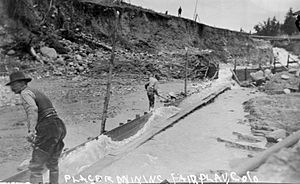
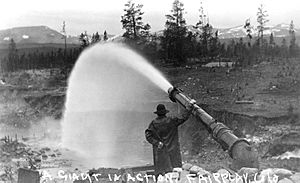
In 1859, prospectors found rich placer gold deposits on the west side of South Park. These deposits were in valleys on the east side of the Mosquito Range. The town of Alma, Colorado, which was the center of this area, was started by miners on December 2, 1872. However, mining had been active there since 1860.
The main mining areas were the Alma-Fairplay district, near the start of the South Platte River. Another was the Tarryall district, along Tarryall Creek. Later, important lode gold deposits were found above Alma.
A large floating dredge machine worked the South Park valley floor east of Fairplay from 1941 to 1952. It left behind the distinct gravel ridges you can still see today. The Tarryall district produced about 67,000 ounces of gold, mostly from placer mining. The Alma-Fairplay district produced 1.55 million ounces, with more than two-thirds coming from lode deposits.
Before digging into the mountains, prospectors in Park County used placer mining to get gold from rivers and streams. Placer mines appeared all over Park County after 1861. Gold was found in Tarryall, Fairplay, Alma, Breckenridge, and Leadville. A lot of gold came from the beds of the South Platte River.
Many placer claims were south and west of Alma. The mining town of Montgomery had a small placer gold operation in 1911. Two famous placer mines in the Alma area were Snowstorm and Cincinnati. In 1882, the Alma Placer Mining Company owned about 640 acres of placer mines. The only problem was that this type of mining could only be done during the short summer months.
After finding gold in gulches, prospectors moved to the more challenging mountain veins. This is called lode mining, where miners dig deep into the earth. Lode mining costs more than surface mining. It also has risks like losing air, explosions, and cave-ins. But like everyone hoped, gold was found in these lode mines.
The first lode mine in the Alma area was in Buckskin Gulch. It was explored by a local person named Joseph Higginbottoms, also known as Buckskin Joe. That first mine was called the Phillips Lode Mine. In its first two years, it produced $300,000 worth of ore. Once the gold ran out, they started mining for quartz.
The Paris Mine, also in Buckskin Gulch, was another lode mine that produced oxidized gold. The London Lode Mine, off Mosquito Gulch, produced gold, silver, and copper. The Magnolia Mine in Montgomery was known for producing gold, lead, silver, and copper. It also produced quartz, pyrite, and limonite.
Leadville: From Gold to Silver and Back
The story of the Leadville area began in April 1860. One of Colorado's richest placer gold discoveries happened at California Gulch, where Oro City was located. Another rich discovery was made at McNulty Gulch.
The placer gold was used up within four years. But then, lode gold was found in 1868. These gold discoveries led to the finding of huge silver deposits in 1877. This led to the founding of the city of Leadville. The Little Johnny silver and lead mine, started in 1879, was further developed in 1893. This led to a lot of high-quality gold-copper ore being produced. The Leadville district produced 3.2 million ounces of gold. Most of this gold was found as a side product while mining for silver.
Summitville: A Modern Mining Story
Prospectors found placer gold in 1870 in the Wrightman Fork of the Alamosa River. Gold veins were discovered in 1871. Large-scale mining began in 1875 after a mill was built. By 1880, the Little Annie vein helped make Summitville Colorado's biggest gold producer. Over 100,000 ounces of gold were produced by 1890. Mining continued until 1906, then happened off and on after that. By 1990, gold production was 520,000 ounces.
In 1985, Summitville Consolidated Mining Company started a new type of mining. They used open-pit mining and a method called heap-leach mining. Mining stopped in 1992. The company went bankrupt in December 1992. The US Environmental Protection Agency (EPA) had to step in. They worked to prevent pollution from the mine. The EPA declared it a federal Superfund site in May 1993. This means it was a very polluted site that needed a lot of cleanup. The cleanup cost was estimated to be between $100 million and $120 million.
In 1998, the mine's general manager and environmental manager were found responsible for environmental issues. They were each given six months of probation and had to pay $20,000 fines.
Sneffels-Red Mountain-Telluride: Gold in Volcanic Areas
The Sneffels-Red Mountain-Telluride district was discovered in 1875. It is in San Miguel and Ouray counties, at the southwest end of the Colorado Mineral Belt. Thomas Walsh developed the Camp Bird Mine in 1896. This area is near and inside an old volcano. The gold deposits are found in veins and other rock formations. By 1959, this district had produced 6.8 million ounces of gold. It also produced a lot of silver, lead, and copper.
Cripple Creek: Colorado's Biggest Gold Producer
A cowboy named Robert Womack found gold in 1879. He dug many holes trying to find where the gold came from, earning him the nickname "Crazy Bob." His hard work paid off in 1890 when he found the El Paso lode. Winfield Scott Stratton discovered what became his Portland Mine. By 1893, 10,000 miners were working in the area. They produced one-third of all the gold in Colorado.
New ways to get gold, like Gold cyanidation and chlorination, were introduced in 1895. By 1895, half of Colorado's gold (660,000 ounces) came from this district. In 1897, half a million ounces of gold were produced. In 1900, 900,000 ounces were produced, which was two-thirds of the gold produced in the entire United States! By 1920, 41 mines were active. They had produced over 500 tons of gold in total.
The Cripple Creek district was found later in the "rush." It was called the "Pike's Peak Gold Rush" because Pike's Peak was a landmark visible from far away. The towns of Cripple Creek and Victor were built to support the mines and miners. Important mines included the Mollie Kathleen Gold Mine at Cripple Creek and Stratton's Independence mine at Victor, Colorado.
By 1990, this district had produced 21 million ounces of gold. This made it the most productive gold-producing area in Colorado. It was also the third-most productive in the United States. Many of the mines in this area were very deep and hard to keep dry. The almost 5-mile-long Roosevelt Tunnel was dug between 1907 and 1919. It helped drain water from the mines and made it easier to move the ore.
The Cripple Creek mining district is inside an old volcano. The gold and silver are found in veins and other rock formations. The minerals found there include gold and silver tellurides, along with fluorite.
The Cripple Creek & Victor Gold Mining Company started in 1976. They began mining again in the area. From 1976 to 1989, they produced 150,000 ounces of gold. They did this by reprocessing old mining waste and digging two small surface deposits. In 1994, the company started the first large-scale open-pit mining in the district. The Cresson mine open pits are a few miles north of Victor. Mining continues today under the ownership of Newmont Corporation. They increased gold production from 211,000 ounces in 2014 to 451,000 ounces in 2017. In 2019, they produced 322,000 ounces.
Gold Mining in Colorado Today
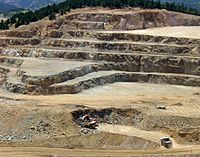
Colorado's gold production was 270,000 ounces in 1892. It reached 660,000 ounces in 1895. The peak was in 1900, with 1.4 million ounces. It stayed over one million ounces until 1916. Production was 300,000 ounces in 1922 and 200,000 ounces in 1928. The Gold Reserve Act helped increase production to 370,000 ounces in 1936.
Production was 380,000 ounces before a government order (L-208) stopped gold mining in 1942 during World War II. Mining started again after the war, with 168,000 ounces in 1947. Gold production was 66,000 ounces in 1960 and 22,000 ounces in 1967. It reached 37,000 ounces in 1972 and 72,000 ounces in 1978.
Today, only one mine in Colorado still produces gold. It is the Cripple Creek & Victor Gold Mine at Victor, near Colorado Springs. This is an open-pit mine owned by Newmont Corporation. In 2019, it produced 322,000 troy ounces of gold. As of December 31, 2019, it still had 3.45 million troy ounces of gold reserves that could be mined.


